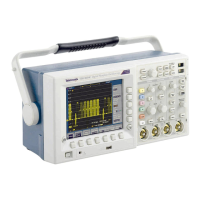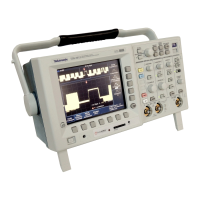University of Portland - p. 4 of 9 - Oscilloscope - TDS3012B.docx
Adjusting the Display
Although the Autoset button automatically selects some of the settings for you depending on the
current input signal, it is often necessary to manually adjust the settings to get a useful display.
The oscilloscope has adjustments that allow you to set the vertical and horizontal scales
independently, and to slide the graph vertically and horizontally.
Adjusting the Vertical and Horizontal Scale
The vertical scale knob shown in Figure 4 adjusts the volts per division setting of the vertical
axis. This adjustment allows you to zoom in to observe small signals and zoom out for large
signals. Note that when you rotate the knob, the value of the volts/division is updated in the
lower left of the screen. In order to get an accurate voltage measurement, we need to set the
vertical scale so that the signal is as big as possible without going off the top and/or bottom of
the screen.
Figure 4: Vertical Scale Knob
The horizontal scale knob shown in Figure 5 adjusts the seconds per division setting of the
horizontal axis. This adjustment allows you to zoom the horizontal scale. Note that when you
rotate the knob, the value of the seconds/division is updated in the lower middle of the screen. In
order to get an accurate time measurement, we need to set the horizontal scale so that the display
shows one or two periods of the signal.
Figure 5: Horizontal Scale Knob
When the vertical position knob (Figure 6) is rotated, the signal slides up or down and the arrow
that marks the location of ground (0 Volts) is updated. The horizontal position knob (Figure 7)
slides the signal left or right.

